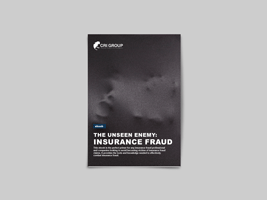This three-part series of articles examines the problem of insurance fraud, including its pervasiveness and general characteristics in the United States, the United Kingdom and the world. Insurance fraud is a widespread problem that requires real solutions and is often difficult to detect and combat.
Part One of the series, “What is Insurance Fraud,” provides an introduction to a topic that is important for any business leader, insurance professional, compliance agent or fraud investigator. Part Two, “How do Companies Detect Insurance Fraud,” details red flags of insurance fraud that help tip off investigators to possible illegal behaviour. Part Three, “Anatomy of an Insurance Fraud Investigation,” provides a look at case studies and reveals key tips for handling a successful investigation. To receive the next series subscribe to our monthly newsletter here!
Taken as a whole, this series is the perfect primer for any insurance fraud professional and companies looking to avoid becoming victims of insurance fraud claims. It provides the tools and knowledge needed to effectively combat insurance fraud.
Part Two: How Do Companies Detect Insurance Fraud?
The insurance fraud epidemic is of serious concern to businesses, insurance providers and consumers worldwide. In Part One of this three-part series, we examined the scope of the problem, and discussed a few cases that illustrate the magnitude of insurance fraud. In Part Two, we answer the question: How can companies detect insurance fraud cases before they do irreversible damage? Working with the right experts, any company can be better protected and detect more insurance fraud.
CRI Group’s expert insurance fraud investigators have the experience and training to help business leaders identify the red flags of insurance fraud, alerting them to
The following are 6 red flags of Insurance Fraud that CRI Group’s investigators are trained to recognise:
1. Suspicious timing
Sometimes a claim is made very shortly after the inception of the policy, such as within months, weeks or even days after the insured has been enrolled. This is an obvious red flag, yet it happens more often than you’d think. Another similar tip-off to potential fraud is when the insured makes a claim soon after an increase or change in the coverage. For example, a motorist increases their auto coverage from liability to collision insurance, and soon after files a claim under their collision policy when their car is “totalled” in a one-vehicle accident. An investigator from CRI Group would certainly look deeper into the circumstances of the claim.
2. Frequent insurance claims and losses
We often hear that “some people are just unlucky.” That may be true, but a string of alleged bad luck that results in frequent insurance claims and payouts can signal that there is more than meets the eye. CRI Group is trained to look at the history of every claimant and uncover potential fraudulent actions. Some insurance fraudsters think they can avoid detection by filing their claims in totally different areas, like auto, health and homeowners’ insurance. Expert investigators know how to put those pieces together to look for trouble signs.
3. Sketchy details
Sometimes a claim for theft or fire will be for recently purchased and/or expensive property, without a lot of documentary evidence to back up the claim. That’s a red flag, along with when an insured cannot remember, or does not know, where the claimed property was acquired, or cannot provide adequate descriptions. A proper insurance fraud investigation will seek to corroborate the details of the claim, and require an examination of all supporting documentation to make sure it is complete and legitimate.
4. Details that are “too perfect”
On the other hand, sometimes the details surrounding a claim seem perfect – a little too perfect. CRI Group has investigated cases in which the insured had receipts and other documentation, witnesses, and duplicate photographs for everything. So what’s the problem? Things lining up a little too perfectly can tip off an investigator that things have been planned and orchestrated, and there might be fraud involved. That’s when it’s time double-check the documentation carefully, and interview witnesses to verify the facts.
5. Irregular documentation
We’ve discussed the importance of documentation in the investigation of a claim – whether it might be missing, or seems to be “too perfect.” But sometimes the documentation provided by the insured is irregular or questionable, which is another red flag of insurance fraud. CRI Group’s investigators look for issues with documentation such as:
- Numbered receipts from the same source, but are dated differently or sequentially.
- Altered documents, including receipts or invoices with dates or amounts changed.
- The insured provides only photocopies of documents, instead of originals.
- Similar handwriting or signatures on different documents that are purportedly from different sources.
- Errors, such as miscalculated sales tax, or name and address misspellings, etc.
These are just a few of the issues that experts are trained to look for, and they know how to read the warning signs in the documentation that a layperson might overlook.
6. Financial difficulties
Most of us have run into financial trouble at least once or twice – overextended credit, bad investments, perhaps an ill-advised purchase. The problem is that some individuals, whether out of desperation or greed, will resort to fraud to try to straighten out such financial difficulties. CRI Group’s fraud investigators are careful to look at all aspects of a claim. Did the insured recently take a financial loss? Did they declare bankruptcy, or go through a costly divorce? These red flags become especially important when paired with one (or more) of the other red flags discussed in this article. Investigators must be vigilant, as financial pressure is one of the leading contributors to fraud.
What comes next?
Insurance fraud cases cover a wide range of schemes and crimes, and the red flags described above are just a few of the issues that insurance fraud investigation companies are trained to look for and uncover in the course of an investigation. In part three of this series, we will examine how CRI Group’s insurance fraud investigators proceed when such red flags lead to fraud, and it’s time to launch an investigation. CRI Group’s investigations cover the full range of insurance fraud cases, from health care fraud to disability and even fake death claims, always with the goal of providing the best resolution for our clients.
About CRI Group
Based in London, CRI Group works with companies across the Americas, Europe, Africa, Middle East and Asia-Pacific as a one-stop international Risk Management, Employee Background Screening, Business Intelligence, Due Diligence, Compliance Solutions and other professional Investigative Research solutions provider. We have the largest proprietary network of background-screening analysts and investigators across the Middle East and Asia. Our global presence ensures that no matter how international your operations are we have the network needed to provide you with all you need, wherever you happen to be. CRI Group also holds BS 102000:2013 and BS 7858:2012 Certifications, is an HRO certified provider and partner with Oracle.
In 2016, CRI Group launched Anti-Bribery Anti-Corruption (ABAC®) Center of Excellence – an independent certification body established for ISO 37001:2016 Anti-Bribery Management Systems, ISO 37301 Compliance Management Systems and ISO 31000:2018 Risk Management, providing training and certification. ABAC® operates through its global network of certified ethics and compliance professionals, qualified auditors and other certified professionals. As a result, CRI Group’s global team of certified fraud examiners work as a discreet white-labelled supplier to some of the world’s largest organisations. Contact ABAC® for more on ISO Certification and training.
Sources & Credits
- LexisNexis Legal Newsroom, titled “Insurance Fraud – Red Flags.” https://www.lexisnexis.com/legalnewsroom/insurance/b/insurance-law-blog/archive/2008/05/16/insurance-fraud-_2d002d00_-red-flags.aspx
- Property Casualty 360, titled “10 red flags that could signal a fraudulent Auto claim.” https://www.propertycasualty360.com/2016/03/16/10-red-flags-that-could-signal-a-fraudulent-auto-c/?slreturn=20180306103605




